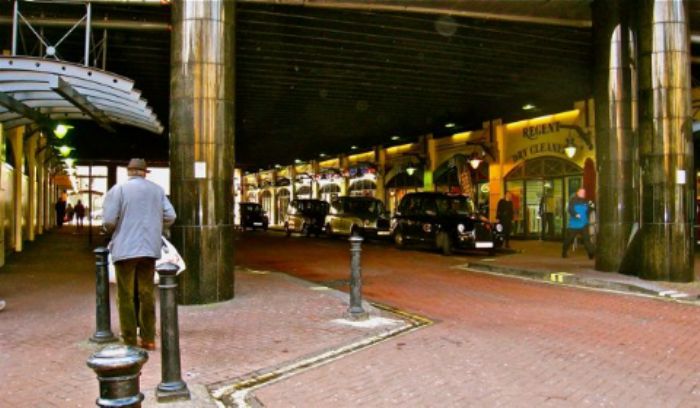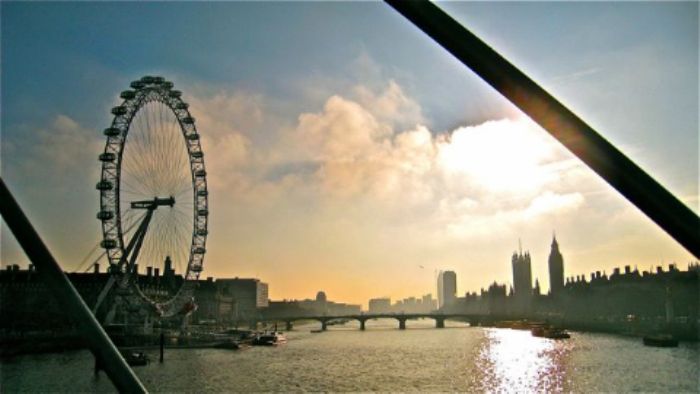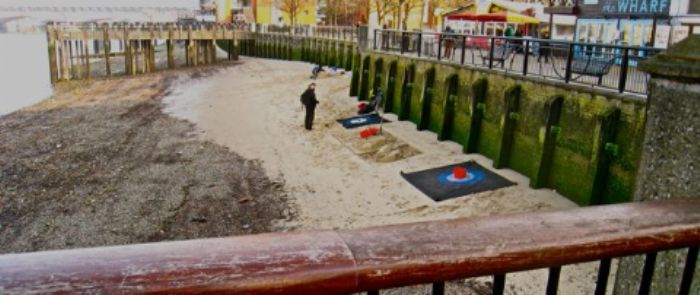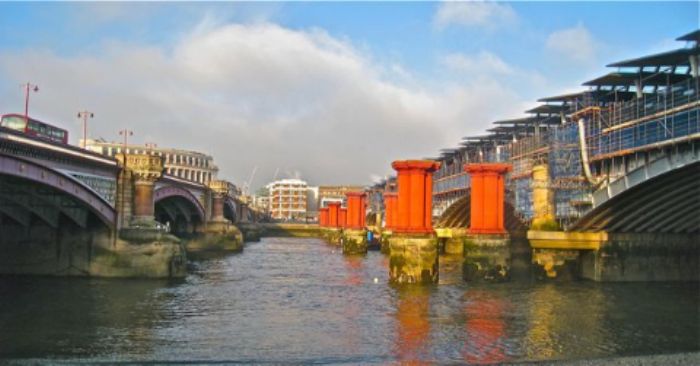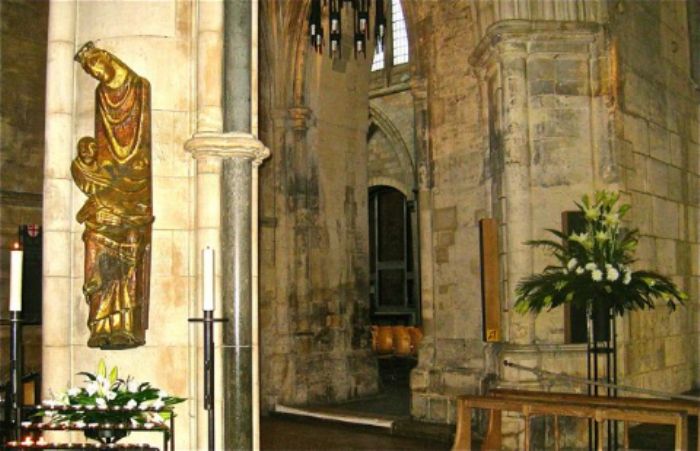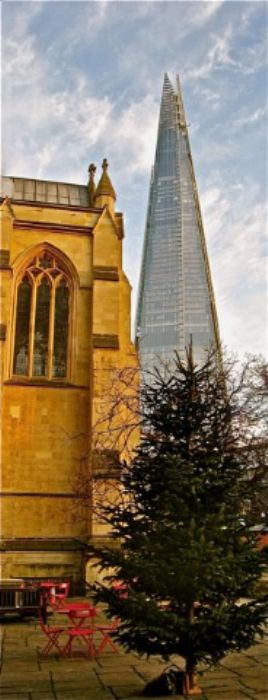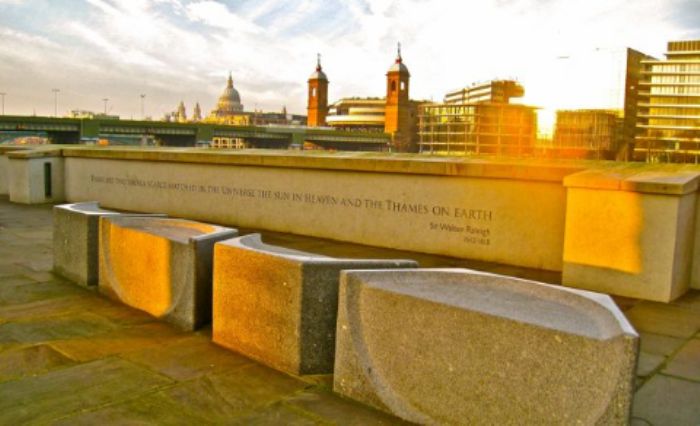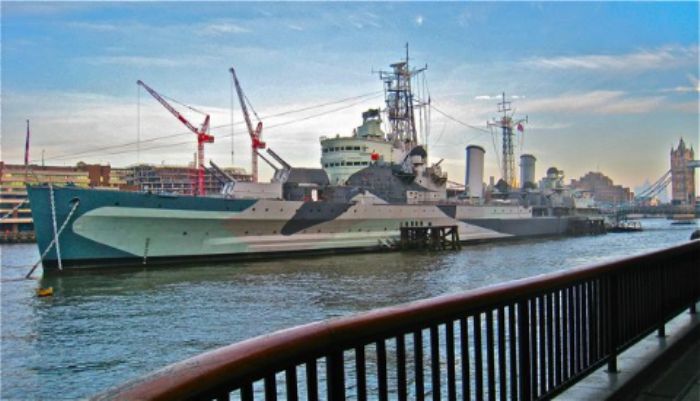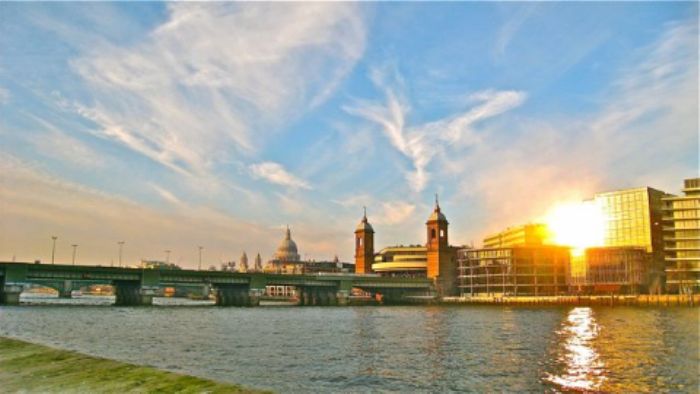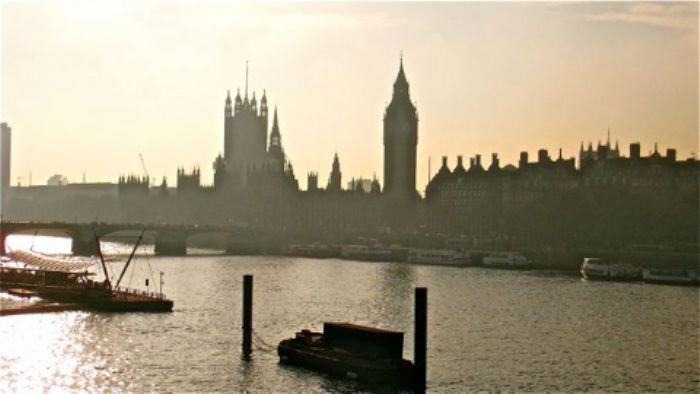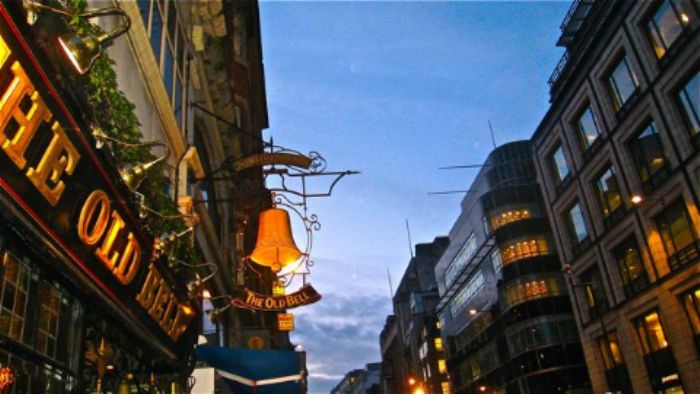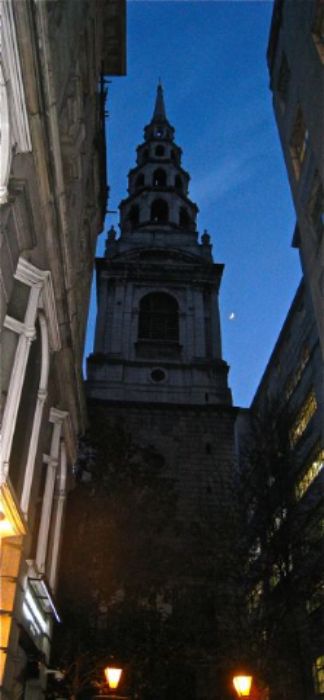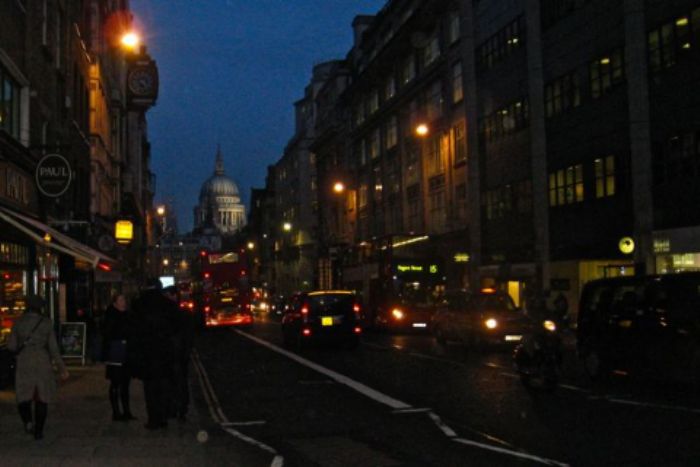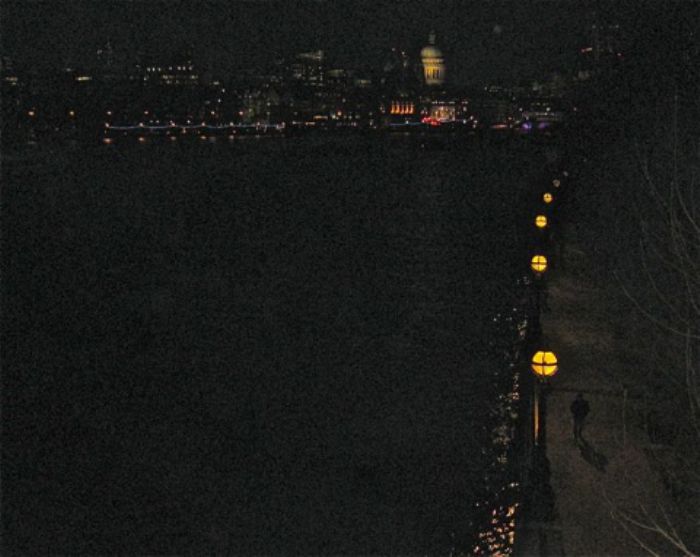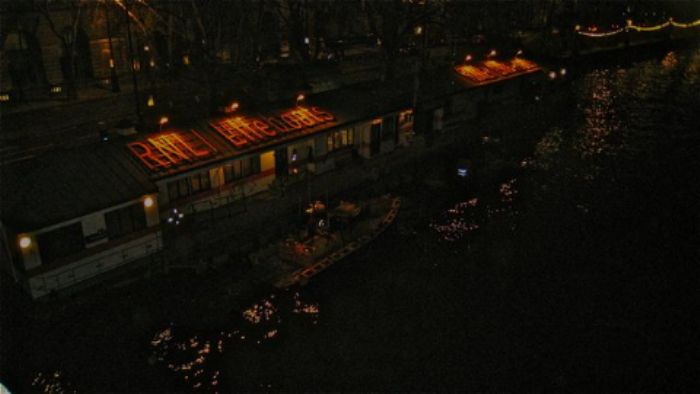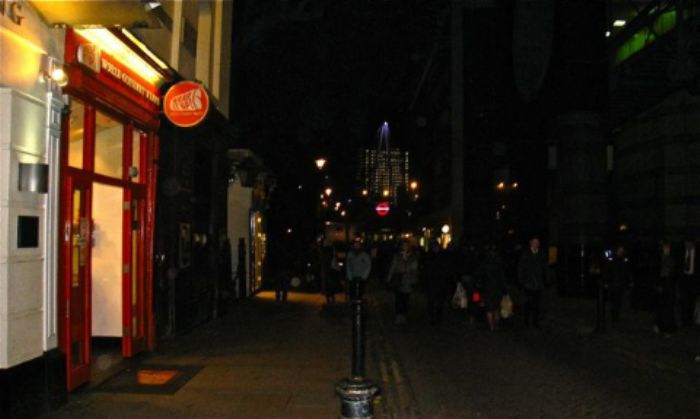When a friend rang suggesting a walk together, I thought of the somewhat ‘rural’ towpath leading from Barnes to Hammersmith. But then I remembered the day before… as I crossed the bridge into Barnes by bus, I noticed that high tide was way up over the path. The thought of deep mud put me off that idea – and yet a river walk still appealed. We ended up meeting at Hungerford Bridge. But a bit more history unfolded before we began our walk.
I have a book called ‘Secret London’ – ‘An Unusual Guide’ by Rachel Howard and Bill Nash. On my way to the Cartier-Bresson photo exhibition at Somerset House the day before in the pouring rain, I had come out of the underground at Embankment. There’s an old fashioned, baroque carved stone archway with iron gates just inside Embankment Gardens. It didn’t seem to have any connection with the buildings around it and the book told me why.
The Thames used to be much wider and shallower. The water used to come up to this arch, which was the river entrance to an impressive building on the bank called York House, then belonging to the Duke of Buckingham. This is all that remains. Most of the grand villas that were built along the former bank of the Thames are gone. At the back of Somerset House, what was once the entrance to the river is now prosaically separated from it by the busy road.
Underneath Embankment Gardens runs the large sewer designed by Bazalgette – along with the more recent District Line. Joseph William Bazalgette (1819 – 1891), was the grandson of Jean Louis Bazalgette, a Protestant from Ispagnac, Gorge du Tarn, where his family had been based for a thousand years. He emigrated from France to England in the eighteenth century. His grandson became famous for building the sewerage system for the whole of London, most of which is still in use today.
It was a grand project, together with the pumping station at Cross Ness, also planned and built between 1855 – 1865 by Bazalgette and another civil engineer, Charles Henry Driver. This has recently been renovated in all its Victorian glory of intricate design and bold colours. I see it as a monument to the joy of a sewerage system – Bazalgette is a great hero of mine along with Michael Faraday (1791 – 1867). There’s a statue of Faraday at the far end of Embankment Gardens. And there is a monument which commemorates Bazalgette’s genius on Victoria Embankment. He not only built the sewer system but had the foresight to double the diameter of the pipes needed, thinking ahead of the expanding population of London. At the time he said he was aware that this was a one off project. If he hadn’t done this the sewer system would have overflowed in the 1960s. All our lives have changed enormously for the better because of the inventions of these two men and their colleagues.
Alongside the pumping station, is an area called Erith Marshes, now a nature reserve, where water voles, small amphibians and various moths flourish. I mention this because the health of frogs is a strong pointer to a healthy environment for all biological life – including us. Sickly frogs = the beginning of the end.
I digress from our walk ahead but as I was reading about ‘York House Watergate’ I had a phone call to say my companion had been held up and would be twenty minutes late. This gave me time to think more about Bazalgette and his solution to ‘The Great Stink’ (1858), when the river overflowed with sewage to the detriment of all. I pursued this when I got home and this is why I came to find out about a man called John Martin (1789 – 1854).
He was so interesting – I had never heard of him before but I fell completely under his spell – so I wanted to include something about his life here. He actually deserves a whole book. There are two in print as far as I can see. One by Christopher Johnstone written in 1974 called ‘John Martin’ and a more recent one by Barbara Morden called ‘Apocalypse Now’ and written in 2010.
John Martin could be best described as a Renaissance Humanist. He was interested in so many different subjects and made practical contributions to many of them. He was very well known as an artist – look up ‘The Great Day of His Wrath’, ‘Belshazzar’s Feast’, The Fall of Nineveh’ – big epic paintings ahead of epic disaster Hollywood films. There was an exhibition of his work at Tate Britain in 2011 and Laura Cumming of ‘The Observer’ wrote an excellent review of it. At the time he was appreciated much more by continental Europe than the Art Establishment in England.
But besides art, he was interested in engineering – his brother was an inventor – and John anticipated the theory of Bazalgette’s new sewage plan twenty five years beforehand. It was difficult even for Bazalgette to get backing for it – only ‘The Great Stink’, when MPs could stand the smell no longer of sewage in the Thames, turned the tables in Bazalgette’s favour. Another idea of Martin’s which he was unable to fulfil at the time was of a circular railway around London. He once said to his son, Leopold, that he would really have preferred to be an engineer rather than a painter. He rose from humble origins, the sale of his paintings helping him to achieve the means to follow his other interests.
At one point he gave up painting altogether to work on health and safety on sea and inland waterways and in mines. In a way he was one of the first environmentalists, being interested in clean air and sewage systems. And town planning in general. He wanted to find ways of making safe fertiliser for farmers by treatment of sewage, so recycling came into that. He was also thinking along the lines of Darwinism.
One of the things he loved doing was hosting parties at his home in Marylebone, so that artists and writers could meet up with well known scientists, thinkers and entrepreneurs. I wish I could have been there – probably just handing out wine and sweetmeats – but having the chance as I did so to eavesdrop on fascinating conversations. John Martin’s life is well worth exploring. For me, it was a door I opened almost by mistake and it took me into a whole new universe.
David had suggested that we make our rendezvous on Hungerford Bridge – west side. This took me under the arches and past a marine sports shop. Oh dear! A lady selling small antiques rents one of their windows and I couldn’t help buying a small Edwardian silver brooch – at a fair price it must be said! David was waiting to show me the glorious view over the river.
And then we walked over Hungerford Bridge, sharing the space between east and west with the familiar, clanking noises of the trains snorting inbetween the walkways. The sun was out, the sky was crisply blue and I was ready and curious to see what lay ahead.
I don’t remember seeing sand by the Thames before but sculptures were being made of it here at Gabriel’s Wharf. There were also a couple of ‘mudlarks’ searching for ‘treasure’ along the shore line.
I’ve walked along the Thames from Waterloo to the Tate Modern many times and once or twice onwards to The Shakespeare Globe Theatre but now my knowledge was getting slimmer and it was such a surprise to come upon ‘The Golden Hind’. This was also the first time I’d visited Borough Market. In the week it’s not as busy as Saturdays but it was still an inspiration. A wonderful array of onions and funghi, cheeses and meaty treats. I ended up buying some crispy, custard filled ‘natas’ from a dark eyed, handsome French boy.
‘Do you want to see inside Southwark cathedral’? said David. I’m not an avid church visitor but a Canadian friend had told me about a sculpture she loved there. I couldn’t remember what it was but a lady guardian of the church gamely joined in the search and I think this must be it. A modern sculpture of a Virgin and Child in wood and slightly ‘gilded’ by Peter Eugene Ball. The extraordinary thing is that it is carved out of a railway sleeper. it must have been surprised at its novel yet tranquil surroundings after years of being pounded by trains… it’s sort of like having two lives in one in a way … not many of us are that lucky! On second thoughts, being run over by umpteen trains every day isn’t much of a life.
Looking at it from the opposite end of the spectrum … it’s now possible to take a trip to the top of The Shard – at a price. The view must be spectacular if you manage to choose a clear day.
We arrived at the HMS Belfast, at rest like a huge camouflaged sea creature supine in the middle of the river, opposite City Hall and with a view onwards towards Tower Bridge.
‘Well’, said David – ‘we can either walk to Tower Bridge and get a bus, or walk on further along the river’ … but I wanted to get back before the golden rays of the sun were extinguished and so we decided to retrace our steps a little and then cross the Thames at the Millennium Bridge.
Does the clarity and serenity of Vermeer come to mind looking at this view?
We parted ways at the bottom of Ludgate Hill. He was going to Farringdon and I was making my way back via Fleet Street as twilight overtook us. People were hurrying homewards. I was about to cross the road when I noticed a bunch of withered yellow roses tied to a post. It was from somebody called Julian. The accident happened ten years ago, said the note but he would always remember her with love. I waited soberly for the green light.
Fleet Street is one of those places where the atmosphere of historical London lingers as strong as garlic on your fingers.
The chill of evening drawing in encouraged me to hop on a bus to the Strand. Unfortunately I hadn’t noticed that it would be going over the bridge to Waterloo and my heart sank as it swung blindly round the corner after Somerset House. There’s a stop near the Waterloo end of the bridge and I jumped off – to be rewarded by some magnificent river views. I stopped to try out some photos in the dark, despite the cold draught coming up from the water.
Then it was down a few alley ways, slipping through John Adam Street, the home of The Royal Society of Arts and ending up on Villiers Street with Embankment station beckoning me at the bottom. I saw a sign on the left – appropriately telling me to ‘Wrap It Up’. And so I did, happily finding a seat on the District Line back to south west London.
PS I put on the television when I got home to find Michael Portillo sailing down the Thames, following the selfsame route as us. An aeriel view was a satisfying pointer along the riverbank we had so recently followed. I saw we really hadn’t walked very far in the larger scheme of things. MP carried on further than us (by boat) and got a chance to be shown round the sewage treatment pumping station at Cross Ness, continuing on to the Thames Barrier, which has been used recently to keep London from flooding.
That morning before leaving I had read an article by John Kay in the Financial Times entitled ‘The lesson of Victorian London’s rise from sewer to spectacle’. Were these coincidences all an example of ‘synchronicity’ ? And what, if anything, was I meant to be doing about it? It would be a great honour if I could sit down and listen to Bazalgette, Martin, Faraday et al right now because I’m sure they would have some fascinating ideas and inventions wherewith to solve some of today’s problems. It would be wonderful to see them enjoying the advantages of finding information at speed on the Internet. Ah well …. that isn’t likely but we owe it to them to get results like they did, which massively benefited future generations … we have to succeed in spite of adversity, just like them! Sweet dreams …
END

